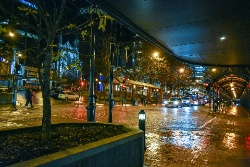A National Conservation Treasure Is Unveiled
Thursday, 20 May 2004
A National Conservation Treasure Is Unveiled
Transwaste Canterbury Limited is today [Thursday, 20 May 2004] officially launching its plans to set aside 410 hectares of land in the Kate Valley for a new conservation area, to be known as Tiromoana Bush, which will be protected forever and open for the public to enjoy from late next year.
The multi-million dollar bush restoration work planned will create a national treasure. The project will result in hundreds of hectares of pasture being restored to a predominantly lowland forest ecosystem, which will support a dynamic mix of native plants and bird life. The area, which has been farmed as part of Tiromoana Station for over a century, will eventually return through active planting and natural regeneration to a condition similar to the original lowland and coastal forest that existed before people first set foot there.
A new 12-hectare wetland will also be established, adding to the network of smaller natural wetlands in the vicinity.
“Transwaste believes Tiromoana Bush will become a jewel in the crown of the Hurunui, providing tremendous recreational, educational and scientific opportunities for future generations of New Zealanders and tourists,” says Denis O’Rourke, chairperson of Transwaste.
Transwaste has seized the wonderful opportunity that has arisen from the purchase of Kate Valley land for the Canterbury Regional Landfill, to make a large portion of the area available for people to use and enjoy.
“Tiromoana Bush will live on long after the landfill has closed. This bush is being created in an area extraordinarily rich in scenic and natural values and will be around for centuries for the public to enjoy,” says Jim Fulton, chairperson of Canterbury Waste Services. Permanent protection of the site will be secured through the establishment of an appropriate covenant, such as a QEII National Trust open space covenant. This will ensure that the conservation and recreational values of this valuable bush area will be protected in perpetuity.
Long-term funding of the restoration is secure. Transwaste will directly fund the multi-million dollar conservation and restoration work during the life of the landfill and revenue from a production plantation forest Transwaste is establishing on other land in the Kate Valley will provide ongoing funding after the landfill closes.
The restoration plan, which was developed by Transwaste in consultation with the Department of Conservation, involves a comprehensive programme of conservation, protection and native bush restoration. It will result in an area of national biodiversity significance, which will link up with the adjacent DoC managed Ella Peak Scenic Reserve, previously not easily accessible to the public.
“Tiromoana Bush is a superb example of the private sector, local government and central government working together. This partnership will deliver a national conservation treasure for the enjoyment of present and future generations,” says Denis O’Rourke.
Public Access
A public walking track circumnavigating Tiromoana Bush will be established next year. This will be a loop track, which will take around three to four hours to walk, linking Mt Cass Road to the coast via Ella Ponds wetland and Ella Bush.
“The walk will take in spectacular views of Pegasus Bay, coastal cliffs, valley floors, the wetlands and bush areas. It will also provide foot access to parts of the adjacent DoC managed Ella Peak Scenic Reserve which, being so remote, has been virtually inaccessible to the public,” says Denis O’Rourke.
Information panels will be placed along the walkway explaining the restoration and conservation processes occurring.
Transwaste intends to invite schools from all over Canterbury and further afield to visit both Tiromoana Bush and the landfill as part of its waste education programme and to take part in conservation and restoration activities, such as tree planting.
“Tiromoana Bush will provide an excellent platform for students to learn about biodiversity, bush restoration, wildlife and conservation,” says Denis O’Rourke.
Scientific research providers are very enthusiastic about using the area for restoration and conservation research.
Gauging Success
There will be a comprehensive monitoring programme to assess the success of the restoration work.
This will focus on the recovery of forest remnants and regeneration, the success of the restoration plantings (plant survival) and the abundance and distribution of particular plants and animals.
Transwaste is establishing an advisory group to oversee the restoration.
This group will include experts in restoration and related sciences, neighbours, as well as representatives of the Hurunui District Council, Department of Conservation and Transwaste.
The advisory group will undertake annual reviews of all restoration activities over the previous year, including monitoring and research results, and approve the following year’s work plan.
Transwaste will ensure that the group has the expertise necessary to make the restoration a success.
“That expertise includes detailed knowledge of the environment and ecology, previous experience on similar restoration projects and knowledge of the local area,” says Denis O’Rourke.
Monitoring will take place at the same sites within the restoration area each year to ensure the data is comparable.
Up to 40 photo points will be established at various locations throughout the restoration area. These will be permanently marked with stakes and located using GPS. They will enable photos to be taken annually at the same location, providing a visual record of the restoration’s success. “The monitoring mechanisms we have put in place are an integral part of the Management Plan for Tiromoana Bush. It is vital we have a number of tools to measure the rate of restoration, so we can ensure we are on track to meet our targets,” says Denis O’Rourke.
A Unique Opportunity
“Transwaste is thrilled to be undertaking the restoration of Tiromoana Bush. We have the chance to create a national treasure which will be enjoyed by generations to come…such opportunities don’t come along every day,” concluded Denis O’Rourke.
TIROMOANA BUSH RESTORATION PLAN: THE FINAL VISION
A Management Plan for the Tiromoana Bush Restoration has been prepared by Associate Professor Dr David Norton from the University of Canterbury’s School of Forestry.
The plan outlines Transwaste’s final vision of the restoration.
‘In 300 years’ time the Tiromoana Bush Area will be restored to a predominantly forest ecosystem, including coastal broadleaved, mixed podocarp-broadleaved and black beech forests, where dynamic natural processes occur with minimal human intervention, where plants and animals typical of the Motanau Ecological District persist without threat of extinction, and where people visit for recreation and to appreciate the restored natural environment.’
“The aim is for the ecology of the restored area to reflect what would naturally occur in the Kate Valley. Already a lot of research has been carried out into what sorts of plants and animals were in the area before humans arrived,” says Dr Norton.
The dominant vegetation would have been lowland and coastal forest with trees like totara and matai emergent over a canopy comprising a diversity of other species including ngaio, lowland ribbonwood, narrow-leaved lacebark, lemonwood and kowhai, among others. Small areas of black beech would have also occurred on the least fertile sites.
“Seeds and cuttings will be collected from plants already growing wild in the area will be collected to be used in the restoration. One of the first jobs is to collect any available beech seeds for the new beech forest we will be creating.”
Dr David Norton says encouraging bird life is also an integral part of the restoration.
“One of the major aims is to see the existing native bird populations thrive, so the trees planted must be ideal food sources for them. Another goal is to establish a kereru (native pigeon) population in the area and we believe that can be achieved by planting tree species, such as kowhai, which will provide the birds with an attractive and viable food source,” says Dr Norton.
“Nationally, lowland forest is rare and under represented so this restoration has major environmental significance,” concluded Dr Norton.
TIROMOANA BUSH RESTORATION: WHAT’S INVOLVED
The Tiromoana Bush restoration work encompasses a comprehensive programme of conservation, protection and native bush restoration, funded by Transwaste.
Over a 35-year timeframe, Transwaste will actively plant native bush species to assist and support the natural regeneration that will be occurring. In addition, the existing stand of black beech in the middle valley will be enhanced by further plantings. At least one other new beech area is to be established.
“This is a major undertaking by Transwaste, and is based on a long term vision. Work is starting almost immediately, and people will be able to enjoy the scenic views and the existing natural values of the area as soon as the walking tracks are established late next year. As the trees grow, and the bird life develops, the area will simply get better and better.” says Gareth James, General Manager, Canterbury Waste Services [CWS].
The initial step for the restoration work is to secure the whole of the Tiromoana Bush area (including the adjacent reserve which is managed by DoC) so that all stock is excluded. This will involve upgrading existing fencing and installing new fencing and should be completed by the end of 2005.
The removal of stock and ongoing pest control will prevent animals from damaging new plants.
Also in the next 12 months, the first of several annual collections of seeds from the area’s existing beech trees will be undertaken and propagation of the 25,000 native tree seedlings needed for planting each year will commence.
The Management Plan has established clear outcomes for the area.
Over a 35-year timeframe, the following outcomes should be achieved within the Tiromoana Bush:
Vigorous regeneration will be occurring within the existing areas of shrub land and forest The existing korimako (bellbird) population will have expanded and a new kereru (native pigeon) population will have been established The securing and enhancement of the existing beech forest Restoration plantings and natural regeneration will have been sufficient to ensure good connectivity of the regenerating forest, the existing beech forest and the DoC managed reserve At least one additional black beech forest has been established The area will be being actively used for recreational, educational and scientific purposes
“Although it will take many years to achieve the full vision, what will result is an area extraordinarily rich in scenic and natural values, being part of the national conservation estate,” concluded Gareth James.
TIROMOANA BUSH RESTORATION: WHO’S SAYING WHAT?
“Tiromoana Bush will become a national treasure, providing marvellous recreational, educational and scientific opportunities for present and future generations of New Zealanders and tourists. This is a superb example of local government and private sectors working together to create something beneficial to all parties, including the public.” Denis O’Rourke, chairperson, Transwaste Canterbury Limited
“The overall vision sees the area restored to a predominantly forest ecosystem…the sort that existed before people set foot in New Zealand. Nationally, lowland forest, like that which will make up much of the restored area, is rare and under represented so this project has major environmental significance.” Associate Professor Dr David Norton, University of Canterbury
“Tiromoana Bush will live on long after the landfill has closed. This bush is being created in an area extraordinarily rich in scenic and natural values and will be around for centuries for the public to enjoy.” Jim Fulton, chairperson, Canterbury Waste Services
“This is a multi-million dollar restoration and an extraordinarily generous move by Transwaste, which could easily have put the area into production forest or continued farming it and made money. Instead, what they have decided to do goes way beyond anything we have ever seen from any other infrastructure project in the region.” Denis O’Rourke, chairperson, Canterbury Waste Subcommittee
“Transwaste has taken this opportunity to integrate the pressing needs of Canterbury's refuse disposal with the chance to restore and protect native bush. The company’s 35 year management plan and 300 year vision show a commitment to conservation for many generations. I especially applaud the provision of public access, so the community can get to know and become involved with the area.” David Campkin, North Canterbury Area Manager, Department of Conservation
“This is a major undertaking by Transwaste, and is based on a long term vision. Work is starting almost immediately, and people will be able to enjoy the scenic views and the existing natural values of the area as soon as the walking tracks are established. As the trees grow, and bird life develops, the area will simply get better and better. Although it may take years to reach the full vision, what will result is an area extraordinarily rich in scenic and natural values, being part of the national conservation estate.” Gareth James, General Manager, Canterbury Waste Services
ENDS


 Gordon Campbell: On The Hamas Ceasefire Offer, And Mark Mitchell’s Incompetence
Gordon Campbell: On The Hamas Ceasefire Offer, And Mark Mitchell’s Incompetence Greenpeace: Protest March Against Fast-track Bill Announced For Auckland
Greenpeace: Protest March Against Fast-track Bill Announced For Auckland Wellington Office of the Mayor: Mayor Responds To Housing Minister’s District Plan Decision
Wellington Office of the Mayor: Mayor Responds To Housing Minister’s District Plan Decision Stats NZ: Have Your Say On Modernising The Census
Stats NZ: Have Your Say On Modernising The Census NZ Government: Therapeutic Products Act To Be Repealed
NZ Government: Therapeutic Products Act To Be Repealed The Treasury: Interim Financial Statements Of The Government For Nine Months Ended 31-3-2024
The Treasury: Interim Financial Statements Of The Government For Nine Months Ended 31-3-2024  Government: New Zealand Sign Language Week An Opportunity For Anyone To Sign
Government: New Zealand Sign Language Week An Opportunity For Anyone To Sign


